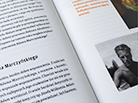‘Andrzej S. Kowalski’ — first, as extensive artists monograph

year of publication: 2013
size: 165 × 240 mm
176 pages
edition: 1000 pieces
binding: softcover
reproductions in colour
languages: mainly Polish, English biography
graphic design: Katarzyna Goczoł
typesetting: Katarzyna Goczoł, Magdalena Machno
publishers: BWA Contemporary Art Gallery in Katowice
Academy of Fine Arts in Katowice
Society of Friends of Rondo Sztuki
ISBN 978-83-61424-50-5
ISBN 978-83-932333-2-8
ISBN 978-83-88254-73-4
Price: about 10 euro (40 zł)
Visit our bookshop or order by e-mail:
ksiegarnia@bwa.katowice.pl

meeting around the book ‘Andrzej S. Kowalski’ We invite to promotion of the book about Andrzej S. Kowalski. This publication is a result of the cooperation between BWA Contemporary Art Gallery in...

Andrzej S. Kowalski 1930—2004 — announcement of the exhibition Andrzej Seweryn Kowalski (1930–2004) — an artist, painter, graphic designer, writer, essayist and teacher, one of the leading figures in Katowice's artistic...

Andrzej Seweryn Kowalski was born on the 23rd November 1930 in Sosnowiec and passed away on the 11th April 2004 in Katowice.
His generation made their debut in the 1950s. Andrzej S. Kowalski studied painting in the atelier of Adam Marczyński, at the Academy of Fine Arts in Kraków. As well as his diploma in painting, he gained another in graphic arts. He became an active member of Kraków's artistic community — collaborated with Teatr 38, worked as an illustrator and columnist writer for the art magazine Zebra, and mixed with the re-activated Kraków Group. At the same time, mindful of his relationship with his native region, he was a member of the Zagłębie Group.
He worked in graphic art and book illustration. By the end of the 1950s, he had blended graphic art with painting, creating his own unique means of expression, the rotopictura technique. He used this to create abstract pictures and prints, which were distinctive for their inherent geometrical elements that introduced a rational type of order into them, while the form itself bore more organic, quivering contours. Their other distinctive feature are hues of ochre, olive, and warm grey, which reverberate in see-through layers with subtle halftones, orchestrating themselves into musical notes. In his works, he was engaged in a dialogue with his contemporaries in the familiar Kraków circles — but he chose a different artistic path. There was more to him than a painter searching for intuitive solutions — he was a thinker, a rationally minded writer and a theoretician.
This double nature, two talents, predisposed him to the teaching profession. He was a much-respected teacher in the Katowice branch of the Kraków Academy, where he worked from 1959 until almost the end of his life. He also collaborated in founding the institute of art at the Cieszyn branch of the University of Silesia, where, for a short time, he educated filmmakers-to-be.
The depiction of Andrzej Seweryn Kowalski would not be complete without mentioning his involvement in the Katowice community – Katowice, not Silesia, which is perceived as opposed to Zagłębie. He believed there was a new historical situation in aspects of human life and society which no longer fitted past divisions and old borders. He was an active member of the Zagłębie and Katowice-based Arkat group, and belonged to the Union of Polish Visual Artists and Designers (ZPAP). Yet another page of his life was participation in the independent, underground anti-communist opposition. Under the pseudonym Andrzej Surowiec he published historical-political works in the underground press. All of those actions stemmed from his sense of duty — both his private life and artistic work were guided by ethical conduct. This is what he strove to realise while teaching and writing or making illustrations, drawings, monotypes, rotogravure prints, secular paintings and sacral polychromes. Finally, he was always willing to offer sound, compassionate advice.







